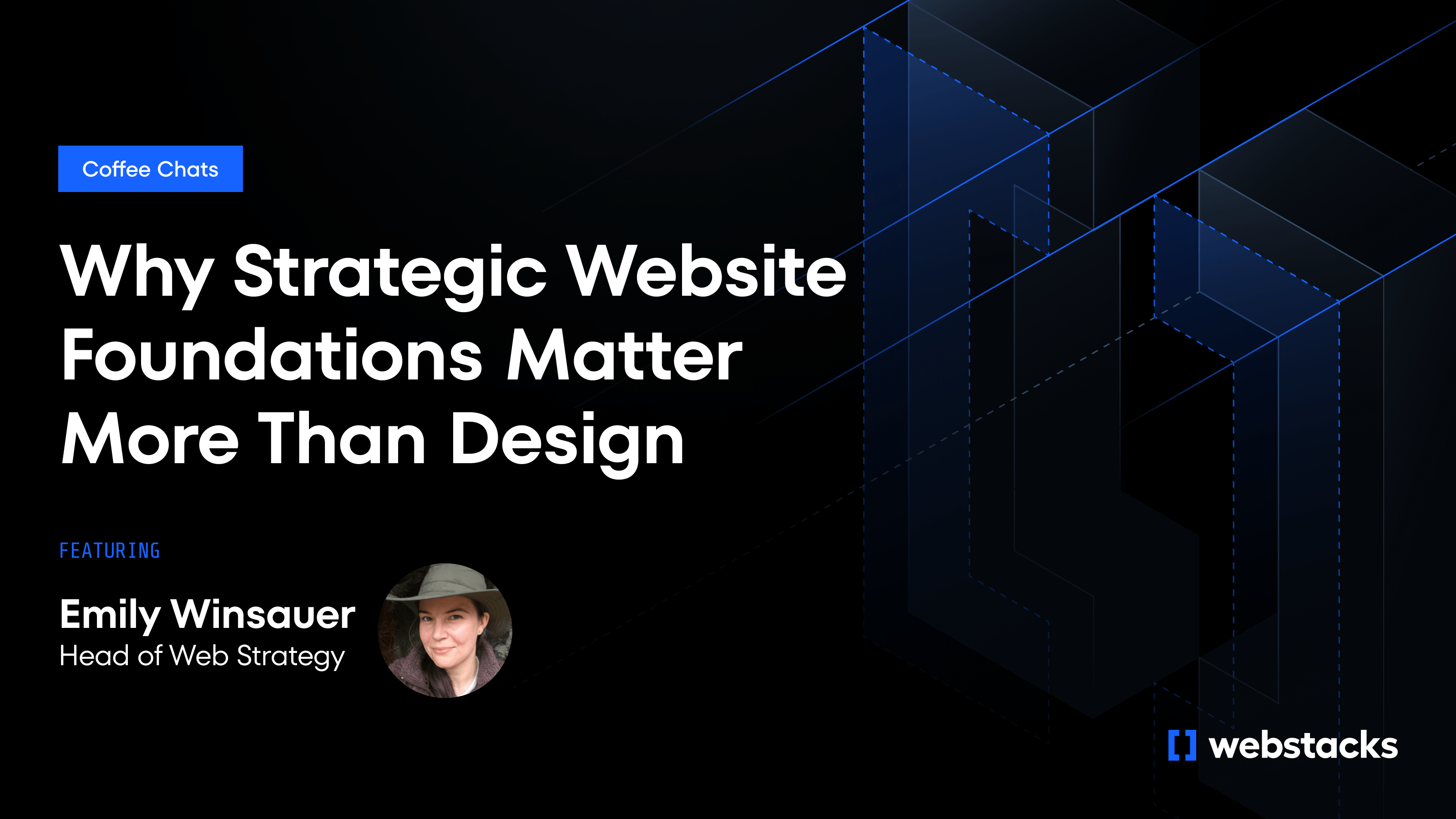At Series B, growth expectations crystallize into hard metrics. Investors scrutinize Customer Acquisition Cost (CAC), retention rates, and Annual Recurring Revenue (ARR) growth. Marketing teams scale paid campaigns and outbound efforts, while product teams ship features weekly and refine Go-to-Market (GTM) strategies monthly.
But most websites still operate like static brochures—slow to update, hard to test, and disconnected from pipeline goals. This creates a critical bottleneck: your team moves at product velocity while your most visible asset lags behind at marketing-pamphlet speed.
The companies that scale successfully treat their website as their fastest-moving product. They push updates weekly, run structured experiments, and use conversion data to inform design decisions. When your site can move as fast as your business, revenue acceleration follows.

The Series B Website Challenge
Your homepage has become due diligence. Prospects research proof points before booking demos. Investors evaluate operational maturity through your digital presence. Partners assess scalability through your public-facing assets.
If your site still reads like early-stage marketing copy—generic value propositions, placeholder screenshots, and vague customer logos—you lose credibility fast. Meanwhile, your competitors are showcasing real metrics, recent wins, and current momentum.
This perception gap has measurable impact. If your website can't communicate traction clearly during this self-service research phase, you're eliminated before the conversation begins.
The solution isn't another redesign—it's treating your website like the product it actually is.
Building A Product-Driven Website
Transforming your website from a static asset into a dynamic product requires a fundamental shift in how you approach content, optimization, and architecture. Instead of treating your site as a marketing deliverable that gets updated quarterly, you need systems that support continuous iteration, real-time responsiveness, and data-driven decision making. This framework establishes three core pillars that enable your website to move at the speed of your business while maintaining the quality and consistency your stakeholders expect.
Real-Time Narrative Management
Series B companies are in constant motion. Product updates, customer wins, funding announcements, and market expansion happen continuously. Your website should reflect this momentum immediately, not months later.
Product-driven sites surface live metrics like active user growth, expansion revenue, and retention improvements directly on the homepage. They feature recent product updates, customer wins, and investor milestones in modular, easy-to-update formats. They replace generic logos with outcome-driven case studies that map to key buyer personas.
Dynamic Conversion Optimization
Your GTM motion becomes more complex at Series B. You're no longer speaking to a single buyer persona—you're selling into new verticals, testing enterprise pricing, and layering on mid-market segments. One-size-fits-all messaging starts to underperform as risk-averse decision-makers require different proof points than early adopters.
Without a system that supports rapid iteration, course-correction takes months. By then, you're already behind competitors who can test and adapt messaging weekly.
Scalable Technical Architecture
Series B growth means more traffic, more campaigns, more content, and more complexity—often simultaneously. If your website runs on hard-coded templates or tightly coupled systems, growth will expose the limitations quickly.
Teams launch region-specific campaigns, add partner portals, and expand product lines. Without modular architecture and API-driven content management, every update becomes a slow, manual process that drains developer time and delays launches.
Building the Backend for Rapid Website Iteration
Scalable infrastructure solves the speed-to-market problem. A component-based frontend combined with a headless CMS gives marketers the ability to ship new pages, localize content, and manage workflows without engineering support.
This architecture prevents backend rebuilds every time go-to-market evolves. Teams can launch region-specific campaigns, add partner portals, and expand product lines without technical bottlenecks.
Implementation Roadmap
Moving from strategy to execution requires a phased approach that balances quick wins with foundational improvements. This roadmap prioritizes changes based on impact, resource requirements, and technical complexity. Start with high-visibility updates that demonstrate momentum to stakeholders, then build the infrastructure needed for sustained optimization. Each phase builds on the previous one, creating compound advantages that accelerate your ability to test, iterate, and scale.
Month 1: Foundation and Quick Wins
Start with changes that deliver immediate credibility improvements and establish your testing infrastructure. These foundational updates require minimal technical resources but create maximum perception impact with investors, prospects, and talent.
Week 1-2: Homepage Social Proof Overhaul
- Replace generic customer logos with specific outcomes: "Acme Corp reduced churn by 23% in 90 days"
- Add quantified traction metrics: "Trusted by 500+ companies processing $2B+ in transactions"
- Include recent momentum indicators: "Featured in TechCrunch this month" or "Series B led by [Specific Investor Name]"
Week 3-4: Basic A/B Testing Setup
- Choose testing platform (Optimizely for enterprise needs, Google Optimize for budget-conscious teams)
- Start with high-traffic pages: homepage, pricing, top-performing landing pages
- Test one variable at a time: headlines, Call-to-Action (CTA) buttons, form fields
- Establish baseline conversion rates for each page
Month 2: Persona-Specific Optimization
With testing infrastructure in place, focus on segmentation and personalization. Series B companies typically serve multiple buyer personas with different pain points, risk tolerances, and decision-making processes. Generic messaging becomes increasingly ineffective as you scale.
Content Differentiation
- Create separate landing pages for your top 3 buyer personas
- Test different value propositions for each segment
- Track conversion rates by traffic source to understand which channels bring which buyers
Modular Content System
- Build content blocks that can be easily updated: recent product updates, customer wins, investor milestones
- Set up monthly content refresh schedule so new visitors always see momentum
- Create industry-specific landing pages for your fastest-growing segments
Month 3: Enterprise vs. SMB Optimization
Enterprise buyers have fundamentally different evaluation criteria than SMB buyers. They require security assurances, compliance certifications, and proof of scalability. This month focuses on creating differentiated experiences that address enterprise concerns while maintaining SMB conversion efficiency.
Risk-Averse Buyer Signals
- A/B test security badges, compliance certifications, and enterprise-specific messaging
- Test different pricing presentations (annual vs. monthly, contact sales vs. self-serve)
- Measure time-to-conversion differences between segments
Advanced Conversion Tracking
- Implement proper analytics tracking for conversion attribution
- Set up automated performance monitoring
- Create dashboard for real-time conversion insights by persona and traffic source
Months 4-6: Technical Infrastructure Scaling
Once you've optimized messaging and conversion paths, technical infrastructure becomes the constraint. This phase focuses on building systems that support rapid iteration and eliminate bottlenecks between marketing strategy and execution.
Immediate Technical Upgrades
- Audit current Content Management System (CMS): Can non-technical team members add pages and content independently?
- Optimize page load speeds (target under 3 seconds)
- Implement Content Delivery Network (CDN) for global speed optimization
- Set up automated backups and security monitoring
Advanced Architecture Considerations
- Evaluate headless CMS migration (Contentful, Sanity) if frequently bottlenecked by technical limitations
- Implement component-based frontend (Next.js, Astro) for faster content updates
- Create staging environment for testing changes before production
- Build API-driven content management for marketing team independence
Stakeholder Impact Beyond Lead Generation
At Series B, your website serves audiences far beyond potential customers. Investors, top-tier talent, and strategic partners all use your digital presence to evaluate your company's trajectory and operational maturity. While lead generation remains important, these secondary audiences often determine your ability to secure funding, attract key hires, and form partnerships that accelerate growth. A product-driven website that demonstrates momentum and technical sophistication creates compound advantages across all stakeholder relationships.
Investor Perception
Investors use your website to gauge operational maturity before meetings. A site that communicates traction clearly, loads quickly under pressure, and demonstrates technical sophistication sends the right signal about your ability to scale.
Companies that secure top-tier Series B funding consistently maintain websites that reflect their growth trajectory in real-time. They update metrics quarterly, showcase recent wins monthly, and refresh messaging to match market positioning.
Talent Acquisition
Engineering and marketing candidates research your company through your website before applying. A dated, slow, or technically limited site signals operational immaturity to the exact people you need to attract.
Partner Confidence
Strategic partners evaluate your scalability through your digital presence. A modular, fast-updating website demonstrates that you can keep pace with partnership demands and market evolution.

Key Performance Indicators for Success
Treating your website like a product requires product-level measurement discipline. Unlike traditional marketing websites that focus on vanity metrics like page views or time on site, product-driven sites track indicators that directly correlate with business outcomes. These metrics help you understand whether your website investments are accelerating growth or just generating activity. At Series B, where every dollar of marketing spend faces scrutiny, measuring the right indicators becomes essential for continued investment and optimization.
Conversion Metrics
These metrics reveal how effectively your website turns visitors into qualified prospects. At Series B, conversion optimization becomes critical as you scale paid acquisition and compete for increasingly expensive traffic. Track these indicators to understand which messaging, design, and user experience changes drive real pipeline impact.
- Homepage conversion rate by traffic source
- Time-to-conversion by buyer persona
- Form completion rates across different page variants
- Demo request quality scores
Operational Metrics
Product-driven websites require operational excellence in content management and technical performance. These metrics measure your team's ability to respond quickly to market changes and maintain site reliability under growth pressure. Companies that excel here can test new messaging weekly and launch campaigns without technical bottlenecks.
- Time from content request to publication
- Number of page variants tested per month
- Developer hours spent on content updates
- Site performance under traffic spikes
Business Impact Metrics
The ultimate measure of website success is business impact, not just traffic or engagement. These metrics connect your website investments directly to revenue outcomes and help justify continued optimization spending. Track these to demonstrate how treating your website like a product drives measurable business results.
- Website-attributed pipeline growth
- Cost per acquisition by landing page
- Sales cycle length for website-generated leads
- Customer lifetime value by acquisition channel
The Competitive Advantage
Series B companies that treat their website like a product gain compound advantages. They respond to market feedback faster, test messaging more rigorously, and scale content operations without linear resource increases.
While competitors wait weeks for website updates, product-driven sites adapt messaging, test new approaches, and optimize conversion paths continuously. This operational velocity becomes a sustainable competitive advantage that compounds over time.
Your Website as Growth Infrastructure
At Series B, your website becomes critical infrastructure for growth. It's not a marketing asset to refresh every two years—it's a live system that should evolve as quickly as your product and go-to-market strategy.
The companies that scale successfully from Series B to Series C treat their website as their fastest-moving product. They build systems for continuous experimentation, empower marketing teams to move independently, and use their digital presence to accelerate every aspect of growth.
When your website can move as fast as your business, it transforms from a bottleneck into a multiplier. That acceleration—in testing, in messaging, in conversion optimization—becomes the foundation for sustainable growth at scale. Book a call with our team to learn more about how websites with composable architecture empower growth-stage companies to scale.




